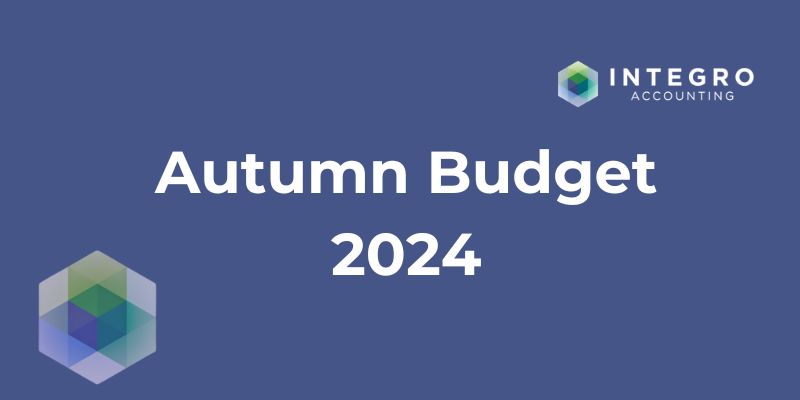Autumn Budget 2024 Overview
1st November 2024

On Wednesday the Chancellor delivered the first Labour budget in 14 years. After nearly 20 minutes of preamble that felt more like listening to a party-political broadcast than a budget, the Chancellor finally set about the task of delivering her plan to “rebuild Britain”.
This is a budget that tinkers with many areas of fiscal policy, so we’ll take a tax by tax look at the points raised that are most relevant to small businesses: from limited company contractors to freelancers and the self-employed. The full detail covering all the points made by the Chancellor on Wednesday can be found in the red book on the government website: Full Autumn Budget 2024.
Income Tax
Income tax has indeed remained steady for the employee but the rise in employers national insurance will leave many small businesses feeling worse off, many of whom will have little capacity in their balance sheets to accommodate such a rise.
The main points for income tax coming out of the budget are as follows:
- Employer’s national insurance contributions (ERNICs) will rise by 1.2% from April 2025 to 15% from 13.8%.
- Personal tax allowances remain frozen until 2028 but will start to rise thereafter.
- Rates for dividend taxes remain the same.
- The employee’s earnings threshold over and above which ERNICs become payable will fall from £9,100 to £5,000, bringing more employees into the chargeable bracket for their employers.
- The Employment Allowance, however, will rise from £5,000 to £10,000 and higher earners with salaries over £100,000 will now be eligible to be factored into the calculation. This allowance effectively gives businesses who have employees in addition to the directors, a rebate on their ERNICs.
- Whilst directors of limited companies will not be able to consider their salaries for the employment allowance, there remains flexibility over how to structure your income. More information on this can be found on our guide to limited company salaries and dividends.
Corporation Tax
Little has changed for corporation tax in this budget and the absence of any rises is welcome. The higher rate stays at 25% and the government have pledged to keep it at this rate for the duration of this parliament.
Small Profits Rate for businesses with a profit under £50,000 remains at 19%. The rules and thresholds for marginal rates for businesses making a profit between £50,000 and £250,000 remains constant too.
The Annual Investment Allowance remains in place with no changes, set at £1 million. This enables all businesses, whether operating as a limited company or a sole trader, to claim 100% relief on the purchase of qualifying equipment – so most assets bought in the course of business.
Capital Gains Tax
Capital gains tax saw some of the more significant changes, some of which are immediate – the changes are as follows:
- Lower rate changed immediately on 30th of October, rising from 10% to 18%.
- Higher rate also changes immediately, rising to 24% from 18%.
- The rate increases bring the main rates of capital gains tax in line with the residential property rates which will stay at 18% and 24% for the lower and higher rates respectively.
- Business Asset Disposal Relief remains unchanged, but will face rises in the future: up to 14% from 10% for disposals made on or after the 6th April 2025; and from 14% to 18% for disposals made on or after the 6th April 2026.
Inheritance Tax
Inheritance tax for businesses also saw some changes, with Business Relief providing 100% relief on the value of a business or its assets up to £1 million, and 50% relief thereafter.
Other points of note
Aside from the main taxes mentioned above there were a few other matters raised in the budget that are of note to small businesses and their owners:
- The additional Stamp Duty Land Tax (SDLT) on second homes went up on the 31st of October from 3% to 5%. This is the amount that is paid in addition to the main rate, when buying a property without selling your main property.
- Business rates are changing and whilst the relief given to retail, hospitality and leisure (RHL) will both drop from 75% to 40% and face a cap of £110,000 per business, the small business multiplier used to calculate business rates will be frozen at 49.9p for 2025/2026.
- Fuel duty remains frozen with the 5p cut introduced in 2022 remaining in place until March 2026. This will be good news for any business relying on vehicles.
- As already announced the National Living Wage for adults will rise. From April 2025 it will go up to £12.21 an hour from £11.44 for adults. The National Minimum Wage for the 18 to 20 age bracket will also rise from April 2025, to £10 an hour from £8.60. This is the beginning of a trajectory that will ultimately align the National Minimum Wage with the National Living Wage.
We have put together this guide as a review of what we consider to be the key points from the Chancellor’s budget on Wednesday. It is not, however, to be relied upon as advice.
If you would like advice on your personal circumstances and how the budget may affect you, please do get in touch with us and one of our experienced accountants will be very happy to help.
Speak to one of our accountants on 0207 096 2659 or book a free call back request at a time to suit you.
